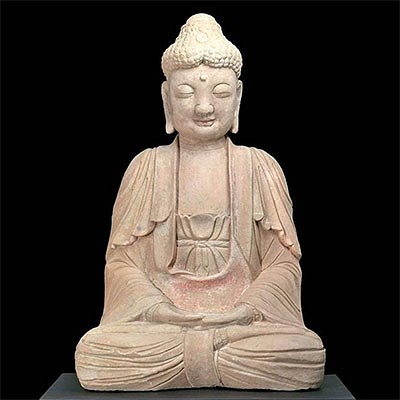Chinese Northern Qi Stone Buddha Head
Lot 78b
About Seller
Artemis Gallery
686 S Taylor Ave, Ste 106
Louisville, CO 80027
United States
Selling antiquities, ancient and ethnographic art online since 1993, Artemis Gallery specializes in Classical Antiquities (Egyptian, Greek, Roman, Near Eastern), Asian, Pre-Columbian, African / Tribal / Oceanographic art. Our extensive inventory includes pottery, stone, metal, wood, glass and textil...Read more
Categories
Estimate:
$4,000 - $6,000
Absentee vs Live bid
Two ways to bid:
- Leave a max absentee bid and the platform will bid on your behalf up to your maximum bid during the live auction.
- Bid live during the auction and your bids will be submitted real-time to the auctioneer.
Bid Increments
| Price | Bid Increment |
|---|---|
| $0 | $25 |
| $300 | $50 |
| $1,000 | $100 |
| $2,000 | $250 |
| $5,000 | $500 |
| $10,000 | $1,000 |
| $20,000 | $2,500 |
| $50,000 | $5,000 |
| $100,000 | $10,000 |
| $200,000 | $20,000 |
About Auction
By Artemis Gallery
Feb 18, 2021
Set Reminder
2021-02-18 10:00:00
2021-02-18 10:00:00
America/New_York
Bidsquare
Bidsquare : Exceptional Antiquities, Asian, Ethnographic
https://www.bidsquare.com/auctions/artemis-gallery/exceptional-antiquities-asian-ethnographic-6373
Museum-worthy examples of Egyptian, Greek, Roman, Etruscan, Near Eastern, Far East / Asian, Pre-Columbian, African / Tribal, Oceanic, Native American, Spanish Colonial, Russian, Fossils, Ancient Jewelry, Fine Art, so much more! Artemis Gallery info@artemisgallery.com
Museum-worthy examples of Egyptian, Greek, Roman, Etruscan, Near Eastern, Far East / Asian, Pre-Columbian, African / Tribal, Oceanic, Native American, Spanish Colonial, Russian, Fossils, Ancient Jewelry, Fine Art, so much more! Artemis Gallery info@artemisgallery.com
- Lot Description
East Asia, China, Northern Qi Dynasty, ca. 550 to 577 CE. A gorgeous hand carved stone sculpture of a meditating Buddha head. Capped by tightly curled hair in a conical shape, symbolizing his nobility, his round visage epitomizes tranquility via his bowed lips, closed in silent contemplation, his austere straight nasal bridge leading to a wide nose, and his large downward cast almond-shaped eyes framed by sweeping arched eyebrows. His flat square chin is flanked by two elongated ears with pendulous lobes, evocative of the time before he renounced all worldly possessions and hung lavish jewels from them. A gorgeous piece of ancient Buddhist art! Size: 6" L x 5.75" W (15.2 cm x 14.6 cm); 9.875" H (25.1 cm) on included custom stand.
The head of the Buddha is perhaps the most significant element of the deity as it represents the immense body of knowledge and wisdom of Buddha along with the tranquil nature that emanates from its expression. A peaceful countenance with a flame Ushnisha symbolizing the wisdom and knowledge acquired after attaining enlightenment, and prominent elongated ears, a physical feature symbolic of the Buddha's time as a prince when he wore elaborate ear ornaments to demonstrate wealth and prosperity. Of course, the prince stopped wearing them when he left the palace to become an ascetic; however, his earlobes remained stretched signifying a renunciation of the material world. Furthermore, the curled, short hair of the Buddha signifies the nobility of Buddha. Beyond the multi-layered meaning embodied in the iconography of this piece, its technique and artistry is exceptional.
Around the 1st century CE, Buddhism came to China along the Silk Road from India; it brought with it an entirely new visual and artistic iconography. The northern rulers of China in the mid-1st millennium CE sponsored the creation of much beautiful and artistically distinct Buddhist artwork. This example is characteristic of the sculpture produced in Shandong province, northeastern China. The discovery in 1996 of over 400 Buddhist sculptures - broken heads and hands, and hundreds of intact torsos, many with gilding and paint still in good condition - in a field that was once the site of a Buddhist monastery in Qingzhou has allowed archaeologists to understand the artwork of this time period much better. The Qingzhou discovery was the largest known group of such sculptures, but other small caches have been found since the 1970s elsewhere in northeastern China. Fascinatingly, most of these sculptures were made during the Northern Qi period, but were buried - based on coins found alongside them - in the 12th century CE, six hundred years later. This seems to have been done to protect the beautiful artwork from the Qi period from anti-Buddhist sentiment.
Provenance: private Studio City, California, USA, collection acquired 2000s
All items legal to buy/sell under U.S. Statute covering cultural patrimony Code 2600, CHAPTER 14, and are guaranteed to be as described or your money back.
A Certificate of Authenticity will accompany all winning bids.
We ship worldwide and handle all shipping in-house for your convenience.
#141941Fragment of a larger piece. Indentations to back and top of head. Minor surface wear with expected nicks, chips, and abrasions as commensurate with age. Intact and excellent with lovely earthen deposits throughout.Condition
- Shipping Info
-
All shipping is handled in-house for your convenience. Your invoice from Artemis Gallery will include shipping calculation instructions. If in doubt, please inquire BEFORE bidding for estimated shipping costs for individual items.
-
- Buyer's Premium



 EUR
EUR CAD
CAD AUD
AUD GBP
GBP MXN
MXN HKD
HKD CNY
CNY MYR
MYR SEK
SEK SGD
SGD CHF
CHF THB
THB














